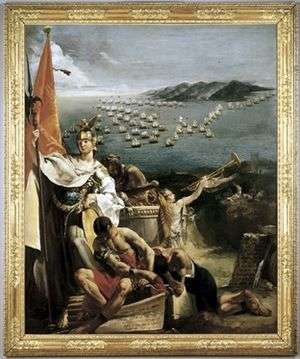Battle of Imbros (1717)
| Battle of Imbros | |||||||
|---|---|---|---|---|---|---|---|
| Part of the Turkish-Venetian War of 1714-1718 | |||||||
 A depiction of the Battle of Imbros | |||||||
| |||||||
| Belligerents | |||||||
|
|
| ||||||
| Commanders and leaders | |||||||
| Flangini | |||||||
| Strength | |||||||
| 44 warships | 26 warships | ||||||
| Casualties and losses | |||||||
| unknown casualties, 6 ships damaged | 1390 casualties, Colomba badly damaged | ||||||
| No ships were sunk in this action. | |||||||
The Battle of Imbros took place on 12, 13 and 16 June 1717 near Imbros in the Aegean Sea. It was a tough but ultimately fairly indecisive battle between a Venetian fleet, under Flangini, and an Ottoman fleet.
History
The Venetians had left Corfu on 10 May 1717 with 25 battleships, and were joined on 18 May by Gloria Veneta. On about 24 May they left for the Dardanelles Strait, anchoring off Imbros on 8 June.
On 10 June at 9am scouts reported that the Ottoman fleet were leaving the Dardanelles with 38 battleships and 6 galliots. Strong winds damaged some Venetian ships and they anchored again. It was impossible to weather Imbros so Flangini formed a line on the starboard tack heading toward Thasos. In the meantime the Ottoman fleet had anchored just outside the Dardanelles.
For 2 days Flangini tried to reach a favorable position but gave up because of strong winds and anchored in lee of Imbros about 12pm on 12 June. The wind then suddenly became ENE and the Ottoman fleet sailed. Because of the current, they reached the Venetians before there was time to form a correct line and Flangini signalled to form up in any order. At 3:30pm fighting began in the Rear with 8 Ottoman ships attacking Colomba, Trionfo (2nd flag of Diedo) and San Lorenzo. Colomba was hit by 2 huge stone shot and, leaking badly, left the line after 1 hour. By then the other ships were in a position to help, and by about 7pm the Ottoman ships retreated, after their fireship was sunk by Trionfo. In the Van, the Venetians had formed a good line of 1st-rates. At about 5pm these were attacked by the main group of Ottoman ships, the fighting lasting till about 9pm. That night, the Venetians, heavily damaged, sailed westward. German troops aboard the nearly sinking Colomba mutinied. Venetian casualties so far were about 570.
On 13 June the Venetians were near the western end of Lemnos, with the Ottoman fleet to the north. Flangini formed a line on the starboard tack. Colomba was to leeward, its place taken by Corona. Toward evening the Ottoman fleet sailed before a north wind and nearly cut off Trionfo and San Lorenzo, which had dropped back. Flangini turned to support them, and a change of wind to the west put him to windward, and the Ottoman fleet retired after only 2 of them had opened fire.
On 14 June the Venetians were between Lemnos and Mount Athos, with the Ottoman fleet to the NNW. The Venetians sailed westward, the Ottoman fleet eastward.
On 15 June the Venetians were becalmed between Mt Athos and Strati. They sailed north slightly in an attempt to get the wind gauge, but on 16 June the Ottoman fleet appeared to windward (NE). Flangini tried to form a NNW line but some ships couldn't keep station and he formed an ESE line instead. At about 9am fighting began in the Van and included all of the line in about 30 minutes. After 5 hours of fighting the Ottoman fleet withdrew with 6 ships badly damaged. Flangini was unconscious and no attempt was made by the Venetians to get the wind gauge, and they retired to Thermia. Venetian casualties were about 840, making about 1390 for the whole battle.
On 22 June the Ottoman fleet attacked the Venetian scouts. Flangini formed a battle line and the Ottoman fleet withdrew. Flangini died later that day.
Ships involved
Venice (Flangini)
- 26 battleships
Ottoman Empire
- Kebir Üç Ambarlı (The Great Three Decker) 114 guns/1500 crew,
- Ejder Başlı (The Dragon) 900 crew,
- Şadırvan Kıçlı (The Sprinkling Fountain) 66 guns/750 crew,
- Siyah At Başlı (The Black Horse) 750 crew,
- Çifte Ceylan Kıçlı (The Two Gazelles) 70 guns/900 crew,
- Beyaz At Başlı (The White Horse) 66 guns/750 crew,
- Kula At Başlı (The Grey Horse) 700 crew,
- Yaldızlı Hurma (The Gilded Date) 70guns/750 crew,
- Büyük Gül Başlı (The Great Rose) 66 guns/700 crew,
- Yılan Başlı (The Snake) 34 guns/750 crew (unique ship with 2x"üç kantar" monster guns firing marble balls),
- Ifrit Başlı (The Demon) 62 guns/650 crew,
- Çifte Teber Kıçlı (Two Halberds) 58 guns,
- Küçük Gül Başlı (The Little Rose) 60 guns/600 crew,
- Zülfikâr Kıçlı (The Two Pointed Sword) 56 guns/650 crew,
- Akçaşehir (Town of Akçaşehir) 56 guns/600 crew,
- Al At Başlı (The Red Horse) 450 crew,
- Servi Bagçeli (The Cypress Garden) 54 guns/500 crew,
- Siyah Arslan Başlı (The Black Lion),
- Ay Bagçeli (The Moon Garden) 54 guns/450 crew,
- Yıldız Bagçeli (The Star Garden) 58 guns/450 crew,
- Yaldızlı Nar Kıçlı (The Gilded Grenade) 52 guns/450 crew,
- Yeşil Kuşaklı (Green Belted) 400 crew,
- Sarı Kuşaklı (Yellow Belted) 54 guns/400 crew,
- Kırmızı Kuşaklı (Red Belted) 52 guns/400 crew,
- Mavi Arslan Başlı (The Blue Lion) 44 guns/400 crew,
- Taç Başlı (The Crown),
- Yıldız Kıçlı (The Star) 40 guns/300 crew,
- Güneş Kıçlı (The Sun) 44 guns/300 crew,
- Mavi Kıçlı Karavele (The Blue Caravella) 38 guns/250 crew,
- Kuş Bagçeli Karavele (The Bird Garden Caravella) 44 guns/300 crew[1]
References
- ↑ Yusuf Alperen Aydın, "Sultan'ın Kalyonları", Istanbul, 2011
Sources
| Wikimedia Commons has media related to Battle of Imbros (1717). |
- R. C. Anderson, Naval wars in the Levant 1559-1853, ISBN 1-57898-538-2
Coordinates: 40°09′39″N 25°50′40″E / 40.16083°N 25.84444°E